INTRODUCTION
As a chemistry professor at a liberal arts university, I find that between breadth of knowledge and depth of knowledge, breadth seems to have the advantage. CSU faculty are, after all, assigned to teach General Education courses which likely have little to do with any specialty we enjoyed when studying for our Ph.D.s. Moreover, my assignments at CSUDH have included stints in the Advising Center and the Offices of Cooperative Education and Telecommunications. My past sabbatical leaves also reflect this diversity. In 1978 I executed a project in computerized test development which evolved into a microcomputer version for which I wrote the software. The program, MICRO-SOCRATES, is still in use today. From 1980 to 1985 I mastered spoken French, finally in Paris at the Alliance Française, so as to be able to expand my circle of colleagues who were pursuing the application of computing to education in English- and French-speaking countries during my leave in 1985. In 1995 I executed a project in genetic engineering and microbiology at a national French laboratory, taking advantage of my fluency in French, my background in chemistry and biochemistry, three summers spent at UCSD working on the Human Genome Initiative and my knowledge of computational methods applied to scientific problems. My leave during the spring semester, 2005 took advantage of my active involvement since 1995 with the World Wide Web as an educational tool. Consistent with all of my Web offerings, it proposed to treat information as knowledge rather than as commodity. It took advantage of my background in science and my knowledge of the use of computers in education. Whereas my earlier leaves dealt with problems specific to computers and chemistry, cultural approaches to education and genetic engineering applied to various plant species, I was pleased, in the spring of 2005, to carry out a project which was, like each of my earlier sabbatical leave projects, something completely different.
Through my travels over the years I have captured thousands of photographs and slides of subjects useful for the courses I teach. Like so many professors, until I discovered the CSU IMAGE project I could envision all of the photos and slides I've captured initially to end up in boxes in the garage and soon thereafter to be transferred to a dumpster by my heirs. The IMAGE Project offers an avenue for such images to be shared with present and future colleagues. (1)
ON THE MATTER OF COPYRIGHT


Let us
begin with the following
three pairs of
images. Each pair is of the same subject, but in
each case the image on the left belongs to
someone and is intellectual property protected
by U.S. Copyright. (2) Each image on the right
was captured by me and has been offered to
CSU faculty, staff and students to be used for
non-profit educational purposes.
We are so inundated by images in the
modern world, both still and animated,
sight bites if you will, that their ubiquity at no charge deludes us into thinking that they are freely
available for our use. Nothing could be further from the truth. Claims of ownership and
copyright protection are more often than not made for these images. The matter of image
availability for non-profit educational use is not a trivial one. Although there 


 are tens of thousands
of images available on the Web and although they may be downloaded for informal personal use
and no one is the wiser, a public institution dare not offer these same images in an archive for
public use without risking unneeded and unwanted problems connected with the ownership of
intellectual property . It is not until an owner of an image states up front that it is being
contributed to an archive for unlimited non-profit educational purposes that the
institution shields itself from any threat of legal problems. The conduit leading from proprietary
interest to non-profit use has been opened by the CSU IMAGE Project so as to remove any doubt
about rights by faculty, staff and students to use these materials for their presentations and their
classes.
are tens of thousands
of images available on the Web and although they may be downloaded for informal personal use
and no one is the wiser, a public institution dare not offer these same images in an archive for
public use without risking unneeded and unwanted problems connected with the ownership of
intellectual property . It is not until an owner of an image states up front that it is being
contributed to an archive for unlimited non-profit educational purposes that the
institution shields itself from any threat of legal problems. The conduit leading from proprietary
interest to non-profit use has been opened by the CSU IMAGE Project so as to remove any doubt
about rights by faculty, staff and students to use these materials for their presentations and their
classes.
It is instructive to recall that an idea, along with ten other categories of human creativity (concepts, discoveries, methods, principles, procedures, processes, systems, theorems, work in which the copyright has expired, and work that the legal owner has placed in the public domain) may not be copyrighted. (3) The idea for each of these pictures, including the spot where the photographer stands to take it, cannot be copyrighted. Moreover, for the purpose of non-profit educational purposes, it doesn't matter if our contributed images are not award-winning photographs. All photographers want their works to be the very best, of course, but for the purpose of exemplifying classroom and laboratory topics, it is the topic which is of importance, not necessarily the quality of the image. The bottom line is that someone must capture an original image and to be willing to donate it to an existing public archive such as that of the IMAGE Project.
THE PRE-FUNDED PERIOD.
The project was divided between the pre-funded period, funded period and the post-funded period. Starting a year before the funded period, the spring semester of 2005, I became well acquainted with rules of cataloguing used by the CSU IMAGE Project and I reviewed IMAGE Project collections in the areas of science and technology, focusing on the categories of scientific instruments, astronomy, calendars, bridges and roads, chemistry, clocks and time, engineering and technology, light and heat, machines and automata, mathematics and measurement, product design, tools, transportation and architecture.
During this period, thanks to three private archives available to me (4), I catalogued and contributed selected images to the IMAGE project so as to become acquainted with the needs and transmission protocol required by the Project staff. I also traveled to Paris in June, 2004 so as to capture images of scientific instruments and technological innovations at the Musée des Arts et Métiers.
Space doesn't permit a narrative for more than a tiny fraction of the images which I have contributed to the collection, but to give the reader some idea of the wealth of image data which was available to me, I'll offer a few examples here.

This is the Pont des Arts in Paris (Oliver Seely, Jr.), dedicated in 1804 as the first iron
bridge built in that city. It leads from the Institut de France on the left bank to the Louvre on the
right.
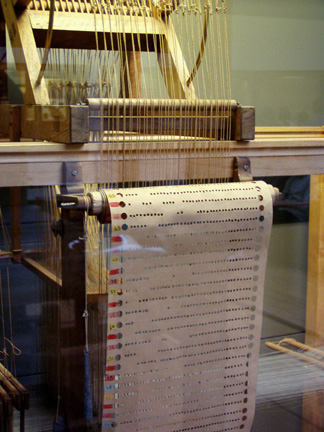
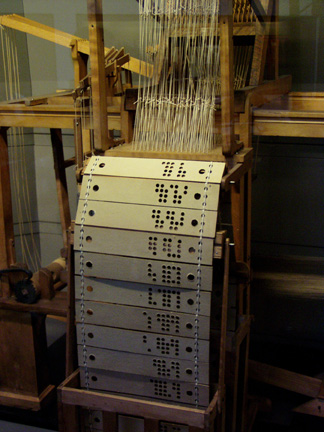
Basile Bouchon and Jean Philippe Falcon contributed to the development of the automatic horizontal loom which was finally perfected by two assistants to Joseph Marie Jacquard. The images on the left and right (Oliver Seely, Jr.) illustrate the technological development of the loom by Bouchon who used holes punched in paper on a long roll and Falcon who introduced cards using a similar coding procedure. Falcon's system was superior because torn cards could easily be replaced whereas Bouchon's system required whole rolls to be reproduced if one tear made a roll unusable.
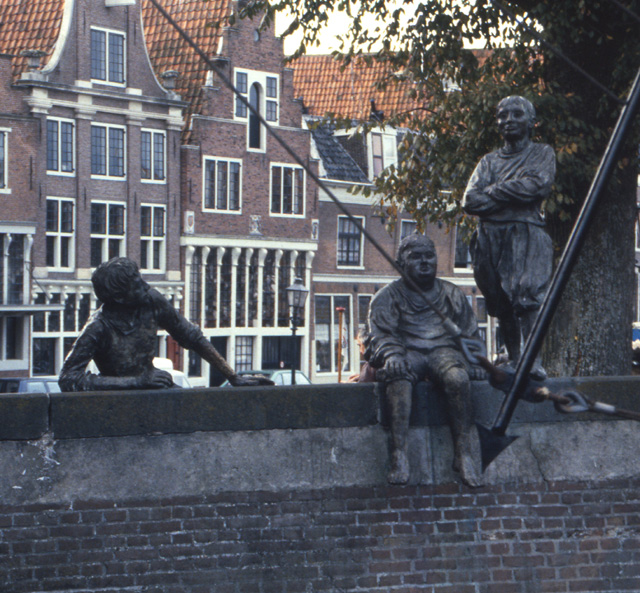 These are "De
scheepsjongens van Bontekoe" (The Cabin Boys of
Bontekoe), the principal characters in the 1924 children's adventure
story by Johan Fabricius based on the journal of Captain Willem
Ysbrandsz Bontekoe about his voyage to Java in 1618. The original
chronicle gave a vivid account of the unparalleled adventure and
peril of transport and trade on the high seas in the 17th century.
Though the "Cabin Boys" became a best selling children's fictional
adventure when it was first published, the source material was
factual and exemplifies the position of world leadership in trade
enjoyed by the Dutch East India Company and the influence on that
trade of the sleepy (today) little port of Hoorn in Holland, little more
than a recreational marina smaller than either of the marinas in Long Beach, CA. The statues
which
stand on a quay at Hoorn gaze toward the North Sea allowing us to imagine their encounters with
strange
people and exotic lands in the South Pacific.
These are "De
scheepsjongens van Bontekoe" (The Cabin Boys of
Bontekoe), the principal characters in the 1924 children's adventure
story by Johan Fabricius based on the journal of Captain Willem
Ysbrandsz Bontekoe about his voyage to Java in 1618. The original
chronicle gave a vivid account of the unparalleled adventure and
peril of transport and trade on the high seas in the 17th century.
Though the "Cabin Boys" became a best selling children's fictional
adventure when it was first published, the source material was
factual and exemplifies the position of world leadership in trade
enjoyed by the Dutch East India Company and the influence on that
trade of the sleepy (today) little port of Hoorn in Holland, little more
than a recreational marina smaller than either of the marinas in Long Beach, CA. The statues
which
stand on a quay at Hoorn gaze toward the North Sea allowing us to imagine their encounters with
strange
people and exotic lands in the South Pacific.
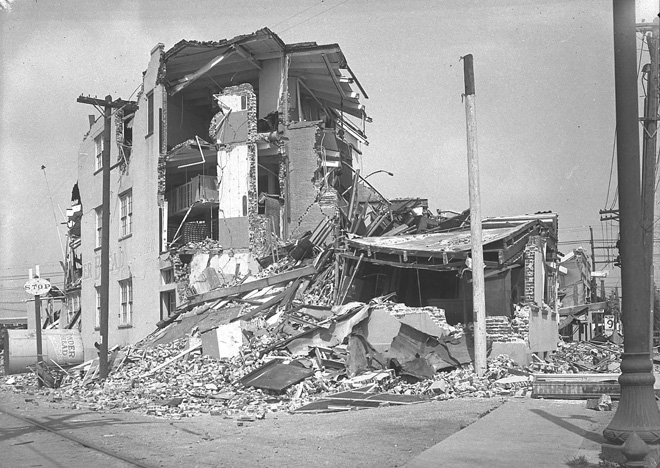
Private archives more often than not yield photographs of events which are one-of-a-kind, either a look at a bygone era or an event so unusual that having it documented is important for the historical record. Here are some which fall into that category:
The Continental Baking Company in Long Beach, California was destroyed by the Long Beach Earthquake which is estimated to have measured 6.25 on the Richter Scale. (Oliver Seely)

In 1952, Mirror Lake in Yosemite National Park lived up to its name, as seen here at the right showing the symmetric reflection of Mt. Watkins. (Hubert A. McClain) Today, the spring snow melt still renews the lake fed by Tioga Creek, but the encroaching vegetation is said to be turning it into a meadow. (Oliver Seely, Jr.)

In October, 1966, the Pink Lady made her debut over a tunnel on Malibu Canyon Road and surprised and entertained northbound drivers. Highway officials were not amused; drivers were stopping along the road to gaze and there was the ever present danger of traffic accidents. Within 5 days the image was obliterated by 14 gallons of brown paint. By that time many enterprising photographers captured the essence offered by local artist Lynne Seemayer who felt that the Lady's spirit of abandon, frolicking naked on the beach with a bouquet of lilies, would offer a welcome respite to an otherwise mundane drive through Malibu Canyon. (Hubert A. McClain)
 In 1972,
visitors to Stonehenge, the best
known of all megalithic sites, could still
walk and picnic between the prehistoric
monoliths. Soon thereafter, fearing that tourists and natives alike were loving the monument to
death, officials built paths encircling the site at a good distance so as to protect it from vandals,
graffiti artists and loving tourists. (Oliver Seely, Jr.)
In 1972,
visitors to Stonehenge, the best
known of all megalithic sites, could still
walk and picnic between the prehistoric
monoliths. Soon thereafter, fearing that tourists and natives alike were loving the monument to
death, officials built paths encircling the site at a good distance so as to protect it from vandals,
graffiti artists and loving tourists. (Oliver Seely, Jr.)
Over the years I have built Web pages for the classes I teach with exemplification where possible using still photos and videos. When the World Wide Web first rather exploded on the scene (didn't it, just?) around 1995 I saw the great potential for offering information to anyone with a connection to it, whether living in an industrialized or a third world country. My first offerings were tables taken from the Handbook of Chemistry and Physics, scanned, reformatted and converted to html format. My strategy was to pick a dozen or so tables of interest of a length not to exceed ten pages simply to learn the technique necessary to make this information available to Web users. I did it also to test the waters of the U.S. Copyright Law. A mentor of mine several years before had advised, "Ollie, you never make any progress unless you take a chance." I need not have worried, because the Feist Publications vs. Rural Telephone Services decision of 1991 reaffirmed, with Justice Sandra Day O'Connor writing for the majority, that facts simply cannot be copyrighted. (5) Since that time, when I can't find certain information on the Web, I search for it elsewhere and put it up with a link listed on my CSUDH Web page. All of my offerings can be found via links on that page. (6)
Of all the pages I have created, the Physical Properties of Woods and Composition and Properties of Alloys continue to generate a very large number of "hits" and more than a little amusement. Visitors to these pages erroneously believe that I am an expert on woods and alloys. I have had queries from motorcycle mechanics wanting to know details on aluminum alloys used in engine blocks to a cabinet maker in Puerto Rico who wanted me to advise him on a troubling rash caused by Teak dust.
My effort toward making information freely available on the Web continues to interest me. In 2002 I wrote a paper on the matter (7) - a contribution leading up to an on-line conference on Web-based video lecture demonstrations in chemistry - in which I observed
Although there has been a U.S. Copyright Register for 100 years, there is at this time no "public domain register."
Current law allows that a copyrighted work need not display a statement of copyright. Although based on sound logic (a work might be copied illegally having had its copyright statement removed), the law confuses the issue in the mind of the teacher interested only in educational use of information which appears in original works. One encounters a variety of material, including some in the public domain but not explicitly identified and some copyrighted but without a copyright statement attached. It is for this reason that all of my original Web offerings carry the statement (or an equivalent): "The text and photos on this page are in the public domain."
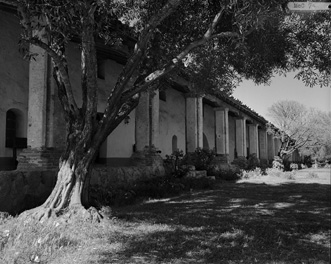
 One day while looking for information on industrial pollution in the
San Gabriel River Channel, I
came across a link to the San Gabriel Mission and was struck by the absence of an image. Further
searching revealed that (at that time) there was no collection of
images of the California Missions on the Web. One of the three
archives available to me includes monochrome images dating back to
the 1950s of all 21
California Missions. I
scanned a few at low
resolution and created a
page. As luck would have
it, at that time for a limited
period, CSUDH was offered
Web monitoring software
and I found over the next
several months that the page
enjoyed a large number of
hits each day. A little
investigation yielded the
information that every 4th
grader in California studies the California Missions, so I
rescanned all of the images at high resolution and expanded my page. (8)
One day while looking for information on industrial pollution in the
San Gabriel River Channel, I
came across a link to the San Gabriel Mission and was struck by the absence of an image. Further
searching revealed that (at that time) there was no collection of
images of the California Missions on the Web. One of the three
archives available to me includes monochrome images dating back to
the 1950s of all 21
California Missions. I
scanned a few at low
resolution and created a
page. As luck would have
it, at that time for a limited
period, CSUDH was offered
Web monitoring software
and I found over the next
several months that the page
enjoyed a large number of
hits each day. A little
investigation yielded the
information that every 4th
grader in California studies the California Missions, so I
rescanned all of the images at high resolution and expanded my page. (8)
All of those images have now been contributed to the IMAGE Project. Here are two from that collection, at left is the Mission La Purisima Concepción at Lompoc and at the right the mission at Carmel. (Hubert A. McClain)
IMAGE CATALOGUING
An important part of the preparation for this sabbatical leave was the process of learning the method used to catalog images. The retrieval software at http://worldart.sjsu.edu works on a file created by Microsoft Excel. This file contains thirty-seven fields, not all of which need to be used for to catalog any particular image. (9) I added a thirty-eighth field, reference number, as a pointer back to the original raw image identifier. In preparation for the funded period a number of allowed identifying words needed to be added to field entries.
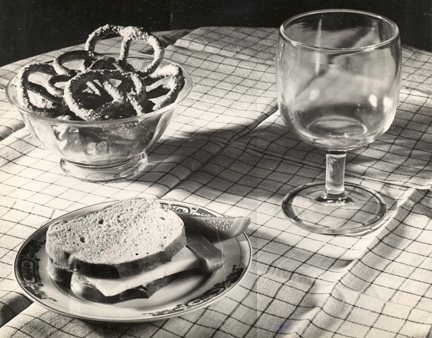

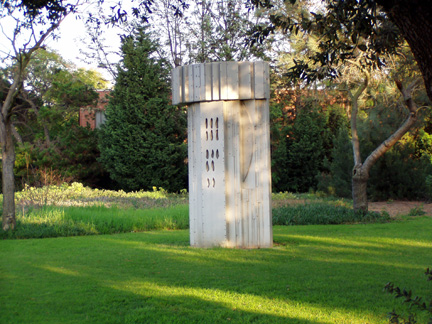 Several
fields led to ambiguities
which had to be worked out
during the course of the project.
"Creator" for example
sometimes referred to the
creator of the image rather than
the creator of the subject of the
image. The creator of
"Awaiting the End of
Prohibition" at the right would
be identified as the photographer (Hubert A. McClain), whereas the "Spruce Goose in Drydock"
at
the left would be identified as the builder (Howard Hughes).
The field "Art Form" might be identified as "photography" as in
the case of the image at the right, above, but as "sculpture" in the
case of "MU464" by Kengiro Azuma at the left.
Several
fields led to ambiguities
which had to be worked out
during the course of the project.
"Creator" for example
sometimes referred to the
creator of the image rather than
the creator of the subject of the
image. The creator of
"Awaiting the End of
Prohibition" at the right would
be identified as the photographer (Hubert A. McClain), whereas the "Spruce Goose in Drydock"
at
the left would be identified as the builder (Howard Hughes).
The field "Art Form" might be identified as "photography" as in
the case of the image at the right, above, but as "sculpture" in the
case of "MU464" by Kengiro Azuma at the left.
The fields "Subject, Object Type, Technique and Materials" usually referred to the subject of the image unless, as in the case of the image above right, the focus was on the creation of the image as an art form. Still, it was necessary in a number of instances to add appropriate entries where adequate identification of the field criterion demanded.
THE FUNDED PERIOD
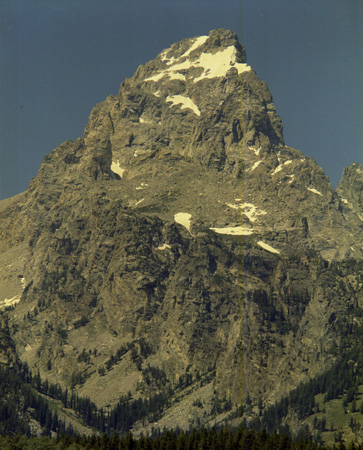 The difference
between selecting images from existing collections for inclusion in the IMAGE Project
archive and of seeking to capture images having broad appeal needs
to be discussed briefly. Images in collections more often than not
are the result of the photographer having rejected a large number of
other images of the same subject before choosing to print the one
found in the final collection. The person who chooses such an image
to contribute is taking advantage of possibly many hours spent
toward achieving the final valued image. For example, the Grand
Teton at the left was the result of a five-day wait for the weather to
be just right to capture this remarkable image. (Hubert A. McClain).
The difference
between selecting images from existing collections for inclusion in the IMAGE Project
archive and of seeking to capture images having broad appeal needs
to be discussed briefly. Images in collections more often than not
are the result of the photographer having rejected a large number of
other images of the same subject before choosing to print the one
found in the final collection. The person who chooses such an image
to contribute is taking advantage of possibly many hours spent
toward achieving the final valued image. For example, the Grand
Teton at the left was the result of a five-day wait for the weather to
be just right to capture this remarkable image. (Hubert A. McClain).
 It must be
accepted that some sacrifices will have to be made when
seeking original digital images for
the IMAGE Project archive. An
image may have to be captured
when conditions are not perfect,
with an understanding that it is
the subject matter which is of primary importance, not necessarily
the artistic excellence of the image itself. Consider, for example,
one of the sculptures which resulted from the International
Sculpture Symposium at CSU Long Beach in 1965, "Duet
(Homage to David Smith)" by Robert Murray. The image could
be legitimately criticized for the shadows which detract from the
geometry of the sculpture as well as the deterioration of the
surface. Still, the form and substance of the piece remains clearly visible. A contributor to the
IMAGE archive might argue that in the interest of seeing that images of these sculptures find their
way to the archive, some sacrifices have to be made and that we leave to future students, staff and
faculty the task of capturing stunning renditions for future generations.
It must be
accepted that some sacrifices will have to be made when
seeking original digital images for
the IMAGE Project archive. An
image may have to be captured
when conditions are not perfect,
with an understanding that it is
the subject matter which is of primary importance, not necessarily
the artistic excellence of the image itself. Consider, for example,
one of the sculptures which resulted from the International
Sculpture Symposium at CSU Long Beach in 1965, "Duet
(Homage to David Smith)" by Robert Murray. The image could
be legitimately criticized for the shadows which detract from the
geometry of the sculpture as well as the deterioration of the
surface. Still, the form and substance of the piece remains clearly visible. A contributor to the
IMAGE archive might argue that in the interest of seeing that images of these sculptures find their
way to the archive, some sacrifices have to be made and that we leave to future students, staff and
faculty the task of capturing stunning renditions for future generations.
 Searching for
images suitable to be contributed to the IMAGE archive can lead down more than a
few blind alleys. I'm always on the lookout, particularly during the funded portion of this
sabbatical
leave, for useful images in the subject areas of science and technology, but it is not unusual to find
what appears to be a promising circumstance such as a museum
of oil well equipment in Taft, California only to have it turn out
to be little more than a theme park. I found no "photo
opportunity" there which could come close to the excitement
pictured by the gushing oil well during the oil boom of the
1920s on Signal Hill. (Thanks to Martha Ebersole Eads for this
dramatic photograph contributed to the IMAGE archive from
the collection owned by her grandfather, Dave Ebersole.)
Searching for
images suitable to be contributed to the IMAGE archive can lead down more than a
few blind alleys. I'm always on the lookout, particularly during the funded portion of this
sabbatical
leave, for useful images in the subject areas of science and technology, but it is not unusual to find
what appears to be a promising circumstance such as a museum
of oil well equipment in Taft, California only to have it turn out
to be little more than a theme park. I found no "photo
opportunity" there which could come close to the excitement
pictured by the gushing oil well during the oil boom of the
1920s on Signal Hill. (Thanks to Martha Ebersole Eads for this
dramatic photograph contributed to the IMAGE archive from
the collection owned by her grandfather, Dave Ebersole.)
It doesn't make sense on the one hand, in a project such as this
one, to travel a long distance with the intention of capturing a
single image only to find out that it is clearly less than one
expected. On the other hand, purposeful travel for capturing
images as they reveal themselves, though certainly more productive, is fraught with the possibility
of
unavailability. One productive way of going about the task is to peruse large numbers of travel
guides, tourist magazines, news reports and other pictorial material to find copyrighted images,
categorize them according to geographical area and to begin one's journey so as to be able to
capture
the very same images for contribution to an archive in the public domain. Even this strategy has
its
shortcomings. The collage below represents the best of three takes on successive days and in my
opinion is unsuitable for inclusion in the archive.

 Notwithstanding the need to adjust the
brightness
and contrast of each segment so as to offer invisible transition from one to the next, it has
problems
of the ubiquitous smog of southern California, and on these particular days there was not a
crispness
to the image which one recalls having seen on earlier
occasions.
Notwithstanding the need to adjust the
brightness
and contrast of each segment so as to offer invisible transition from one to the next, it has
problems
of the ubiquitous smog of southern California, and on these particular days there was not a
crispness
to the image which one recalls having seen on earlier
occasions.
Moreover, pictorial guides are not going to give one ideas about important images to be captured in many areas of science and technology. Such guides simply won't contain for example the face of a kilowatt-hour meter which may be useful in any number of courses which cover subjects in science and technology.
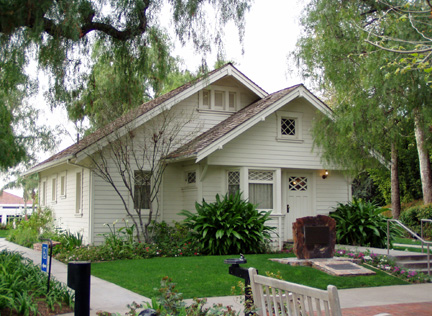 One asks constantly if an image will be a valuable contribution or simply filler. At this early stage
in the life of the IMAGE archive I think one is safe to adopt the opinion that one person's junk is
another's treasure and to take the time necessary to capture for the archive such rather mundane
and "touristy" offerings such as the birthplace of President Richard M. Nixon, shown
here.
One asks constantly if an image will be a valuable contribution or simply filler. At this early stage
in the life of the IMAGE archive I think one is safe to adopt the opinion that one person's junk is
another's treasure and to take the time necessary to capture for the archive such rather mundane
and "touristy" offerings such as the birthplace of President Richard M. Nixon, shown
here.
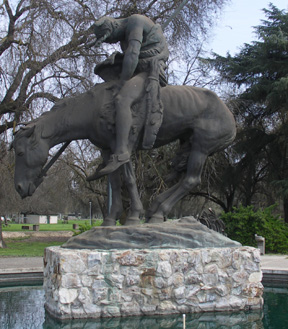
Whereas the early stages of archive construction offer great
freedom to the contributor of photos, a developed archive
demands that the contributor avoid covering old ground.
One would anticipate that over the years of archive
development, the obvious
choices for contributed
images will be tapped first.
The sculpture "End of the Trail," in Visalia, the Picayune one room
schoolhouse in Coarsegold and the Wassama Roundhouse in
Ahwahnee are good
examples.

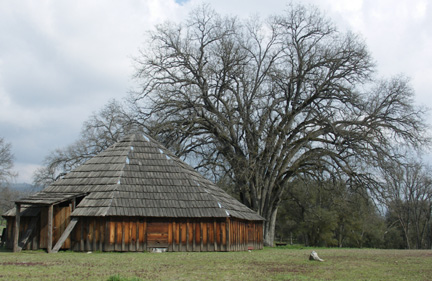

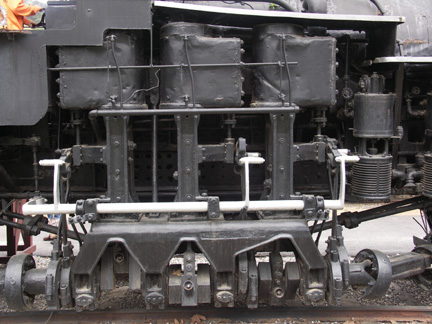 On the
other hand, even well
developed categories in
science and technology are likely to have many specific
topics not well represented. A good example would be
that of the Shay locomotive, designed and built by a
logger, Ephraim Shay, because the existing locomotives
had neither the
mechanical advantage nor the traction necessary to carry great
volumes of timber up
grades as steep as 6%.
The double acting pistons
transmitted force through
the piston shafts to cranks
spaced 120 degrees apart
to offer continual
pressure whatever the
position of the crank
shaft.
On the
other hand, even well
developed categories in
science and technology are likely to have many specific
topics not well represented. A good example would be
that of the Shay locomotive, designed and built by a
logger, Ephraim Shay, because the existing locomotives
had neither the
mechanical advantage nor the traction necessary to carry great
volumes of timber up
grades as steep as 6%.
The double acting pistons
transmitted force through
the piston shafts to cranks
spaced 120 degrees apart
to offer continual
pressure whatever the
position of the crank
shaft.


The piston shaft (1)
pushed the connecting
rod (2) along a slide to
operate the crank below.
The crank shaft turned
the wheels by means of
beveled gears acting on
the wheels at, in this case,
a step-down gear ratio of
2.25. The tender was
also included as a driving
vehicle by universal joints
between the two vehicles.
The
industrial revolution must have been a heady time for people
whose skills would have been wasted both before and after the
surge in industrial growth. Mathias W. Baldwin was one of those
whose skills and business acumen coincided with the needs of the
time. A jeweler and silversmith, Baldwin, George Vail
(ironworker, machinest and later a member of the U.S. House of Representatives) and George W.
Hufty, a machinist, went into a partnership in 1839 to form Baldwin, Vail and Hufty. Baldwin
had
been earlier engaged in the manufacture of bookbinders' tools and cylinders for calico printing. A
stationary steam engine was built on-site to power the factory tools. It performed so well that
Baldwin began to receive orders for ones just like it. In 1831 Baldwin was commissioned to build
a miniature steam locomotive for the Philadelphia Museum; its
great success with museum visitors led to an order for a real one
to run on a short line to the suburbs of Philadelphia. As luck
would have it, the Camden and Amboy Railroad Company
(C&A) had recently imported a locomotive (the John Bull) from
England but had not yet assembled it. Baldwin visited the
storage site and made notes of the dimensions of the parts.
This
simple exercise was the trigger event resulting in the partnership
which became the Baldwin Locomotive Works. The first
locomotive, the steam cylinders of which were bored by hand
using cutting tools embedded in wooden braces and worked by
employees who had to be taught the craft from ground up, was
mounted on a wooden chassis and drove wheels with wooden spokes and rims covered with a
cast
iron tire. It was put in use by the Philadelphia, Germantown and Norristown Railroad on
November
23, 1832 and operated successfully for around 20 years. At the right is locomotive #664 built by
Baldwin in 1899 and donated in 1953 by the Atchison, Topeka & Santa Fe Railroad to the
Travel
Town Museum in Griffith Park, Los Angeles.
The Copyright Problem Revisited
So as to remove all doubt about the hard
reality of the copyright and intellectual property conundrum
for educators, one weekend in April I traveled to Mt. Wilson to get some photos of the dome
housing
the 100-inch telescope. Like all journeys connected with this sabbatical leave, it was a thoroughly
enjoyable affair, though putting myself on the California freeways anymore than is absolutely
necessary carries with it an inherent insanity of our time. Every additional minute one spends
behind
the wheel increases the probability of an untimely demise. Still, it offered me an enjoyable
afternoon.
It turns out that the dome isn't visible in its entirety
from ground level. There are just too  many trees.
The
best place to be is at the top of the 150-foot solar
observatory. From that vantage point one can clearly
see the surrounding area. I did capture the image at the
left but then I wrote to two people, one a curator of
photo archives at the Huntington Library and the other
an astronomer with a key to the solar observatory. The
curator pointed me to the web site www.trove.net
which in no uncertain terms set the conditions for
downloading its images:
many trees.
The
best place to be is at the top of the 150-foot solar
observatory. From that vantage point one can clearly
see the surrounding area. I did capture the image at the
left but then I wrote to two people, one a curator of
photo archives at the Huntington Library and the other
an astronomer with a key to the solar observatory. The
curator pointed me to the web site www.trove.net
which in no uncertain terms set the conditions for
downloading its images:
"All rights, including copyright, in digital representations found on this site are held by RLG or its contributors. You may not copy, download, publish, display, crop, remove watermarks from, or otherwise alter or use any image on this site without RLG's express permission, with the exception of personal use (i.e., "fair use") to the extent it is permitted under U.S. copyright law. Once you have linked to any of the services provided for research or licensing, any use of an image is governed by the terms and conditions of that service."
This statement is approximately normal as regards the protection of intellectual property, but for my taste as an educator, it is far too restrictive. My approach, as you know by now, is to state up front "All of the images on this page are in the public domain. Copying is encouraged!"
The astronomer wrote back that there is a web cam at the top of the solar observatory which refreshes its image every few minutes and if any of those images would work for us we are free to use them. Most unfortunately, they are all low resolution images, and I told him I needed file sizes about ten times larger, but that if at any time in the near future he planned to host a group to ride to the top of the solar observatory, please to include me if at all possible. Meanwhile, what you see (above left) is what you get. The bottom line is to get one's own images when you find them if you do not want to be restricted in any way.
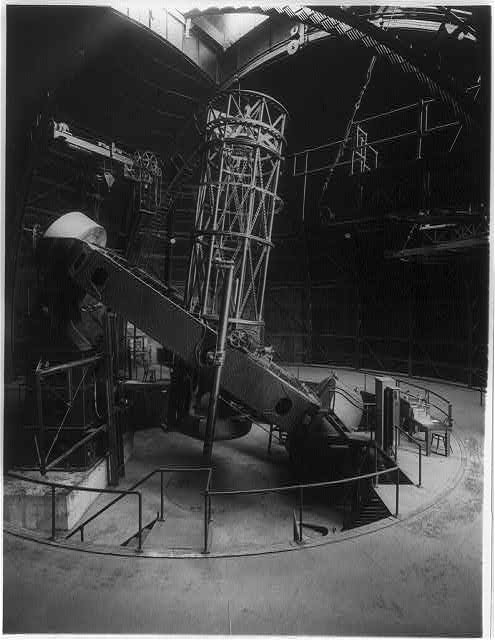
 Still, not to
be dissuaded, I
visited the U.S. Library of
Congress page, www.loc.gov ,
and wrote a message to a
reference librarian asking if the
Library has a public domain
image of the domes and the
mechanism of the 100-inch
telescope. I was sent two low
resolution images, left and
right, and information on how
to obtain high resolution renditions, but the librarian added:
Still, not to
be dissuaded, I
visited the U.S. Library of
Congress page, www.loc.gov ,
and wrote a message to a
reference librarian asking if the
Library has a public domain
image of the domes and the
mechanism of the 100-inch
telescope. I was sent two low
resolution images, left and
right, and information on how
to obtain high resolution renditions, but the librarian added:
"Sometimes, after locating images, we are able to determine from the date or source that it is in the public domain; in other cases, we do not have sufficient information to tell, in which case it is up to you to assess the risks of using the image. In the case of the attached photos, we do not have any information as to who the photographers were or the sources of the photos."
So here is the
100-inch telescope, in use since 1917, and the Library of Congress does not have an
image clearly stated to be in the public domain of the mechanism or
of the dome which houses it. As
the statement above says, the
Library of Congress doesn't own
the images in their collection; the
images fall into several categories
of copyright protection.

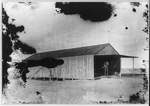 There
are a number for which there are
no restrictions but most fall into
one or another restrictive
category. Here are a couple, left
and right from the Orville and
Wilbur Wright Collection. The image at the left is "Orville Wright at
the Pinnacles," and that on the right (with chemical stains) is
"Building at Kitty Hawk, September 26, 1902." The first is said to
have "No known restrictions," and the second "Rights status not
evaluated." In addition, the Wright collection includes categories of Airplanes, Family, Pets and
Dogs. As I wrote earlier, at this time (as in the case of the choices by the Library of Congress)
anything goes as regards submitting photos to an image archive (if you are Orville or Wilbur
Wright).
There
are a number for which there are
no restrictions but most fall into
one or another restrictive
category. Here are a couple, left
and right from the Orville and
Wilbur Wright Collection. The image at the left is "Orville Wright at
the Pinnacles," and that on the right (with chemical stains) is
"Building at Kitty Hawk, September 26, 1902." The first is said to
have "No known restrictions," and the second "Rights status not
evaluated." In addition, the Wright collection includes categories of Airplanes, Family, Pets and
Dogs. As I wrote earlier, at this time (as in the case of the choices by the Library of Congress)
anything goes as regards submitting photos to an image archive (if you are Orville or Wilbur
Wright).
More seriously, the Library of Congress has a mission to offer images which serve as "keys to a more complete understanding of the people, events, and achievements that have shaped the history and culture of the United States. . ." That is, the LOC decides what images constitute subjects consistent with that mission and potential donors need to understand the subtlety of accepting collections of images belonging to the estate of giants in the history of the United States even though such images coming from you or me might have little interest. That an image might be in the public domain is of lesser importance than the historical stature of the owner of the image's collection. Whereas a teacher asks "may I use this without restrictions," the LOC asks if the image is connected with an event which shaped our history and culture. To that extent, the copyright status of the collections of the LOC are of much lesser importance, except that they be stated when offering them to the public. Having access to a public image archive the entries of which lie unequivocally in the public domain is probably an idea whose time has come, though it will likely be slow to develop because of the lack of incentive (no profit motive) to create such an archive. Meanwhile, nothing is stopping amateurs from seizing the opportunity to assemble independent archives. Where photographs are free from recognizable human subjects so as not to complicate releasing them on the web without concerns about privacy, the possibilities are limitless and we need to get going.
Here are just a few of my contributions to finish out the funded period.



The soaproot plant which can grow to a height of 3 feet was used for glue, food, medicine, soap and fish poison by the California Mono Indians. The fibers which surround the root were useful in assembling a "soaproot brush" for cleaning granite mortars used for grinding acorns.
 This four-lane bridge connects the west end of Terminal
Island to San Pedro, California. Named for the State
Assemblyman who served the San Pedro district, Vincent
Thomas served 19 consecutive terms for a total of 38
years. Crossing the Palos Verdes earthquake fault in
Long Beach Harbor, the bridge received a seismic retrofit
in 1998. As large as it appears to be, its span of 1,500
feet is only a little more than a third the length of the
Golden Gate Bridge in San Francisco. It is so obscured
by container cargo cranes and cruise vessels that some
scouting is necessary in order to find a decent viewing angle, such as the one above.
This four-lane bridge connects the west end of Terminal
Island to San Pedro, California. Named for the State
Assemblyman who served the San Pedro district, Vincent
Thomas served 19 consecutive terms for a total of 38
years. Crossing the Palos Verdes earthquake fault in
Long Beach Harbor, the bridge received a seismic retrofit
in 1998. As large as it appears to be, its span of 1,500
feet is only a little more than a third the length of the
Golden Gate Bridge in San Francisco. It is so obscured
by container cargo cranes and cruise vessels that some
scouting is necessary in order to find a decent viewing angle, such as the one above.

The historic project culminating in the successful completion of the Queen Mary ocean liner was interrupted by the Great Depression. The ship first set sail in 1936 and carried a maximum of 1,957 passengers and 1,174 officers and crew. After completing 1,001 crossings of the Atlantic Ocean it was retired from regular passenger service. Its last great cruise commenced on October 31, 1967 and ended in Long Beach, California on December 9, 1967 where it has served ever since as a museum and conference center.
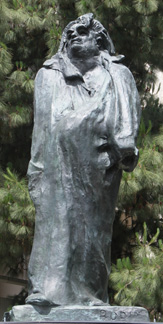 The Société des Gens de Lettres offered
Auguste Rodin a commission for a
monument to Balzac in 1891. For seven years he prepared by reading
Balzac's works and biographies, attempting to understand the psyche of the
literary genius. After having carried out 50 studies, Rodin exhibited a model
in 1898, to scathing criticism and controversy. Not only was it lacking the
academic sculptural style of the time which demanded a finished surface, but
it ignored the expectation that Balzac's already great reputation be magnified
further by a noble visage. It is felt that the deep-set eyes convey the spirit of
Balzac's genius. This is cast no. 9/12 of 1967 which is displayed in the
sculpture garden of the Los Angeles County Museum of Modern Art.
The Société des Gens de Lettres offered
Auguste Rodin a commission for a
monument to Balzac in 1891. For seven years he prepared by reading
Balzac's works and biographies, attempting to understand the psyche of the
literary genius. After having carried out 50 studies, Rodin exhibited a model
in 1898, to scathing criticism and controversy. Not only was it lacking the
academic sculptural style of the time which demanded a finished surface, but
it ignored the expectation that Balzac's already great reputation be magnified
further by a noble visage. It is felt that the deep-set eyes convey the spirit of
Balzac's genius. This is cast no. 9/12 of 1967 which is displayed in the
sculpture garden of the Los Angeles County Museum of Modern Art.
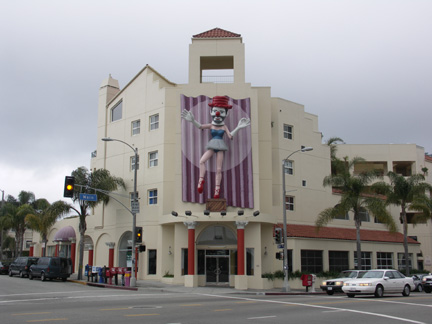
The sculptor Jonathan Borofsky tells us he felt that Venice, California was an appropriate place "to put an image that deals with the duality within all of us. It's a male and a female mixed together--the male clown and the female ballerina, and the duality of performance: the street performer and the ballerina, the traditional, classical performer. A mixing of opposites [in a] splashy, showy kind of way." The Ballerina Clown is displayed at the corner of Main and Rose in Venice.
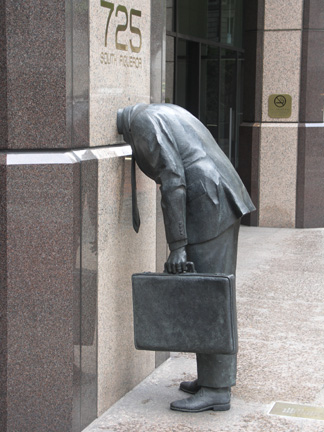 The pressure of corporate America is reflected in this
work showing a business man with his head buried in
the Citicorp Building in Los Angeles. It is said that
employees often touch this piece for good luck as they
pass by. It was sculpted by Terry Allen. Phillip Levine,
the poet, wrote,"They said to get ahead I had to lose my
head. They said be concrete & I became concrete.
They said go, my son, multiply, divide, conquer. I did
my best."
The pressure of corporate America is reflected in this
work showing a business man with his head buried in
the Citicorp Building in Los Angeles. It is said that
employees often touch this piece for good luck as they
pass by. It was sculpted by Terry Allen. Phillip Levine,
the poet, wrote,"They said to get ahead I had to lose my
head. They said be concrete & I became concrete.
They said go, my son, multiply, divide, conquer. I did
my best."
THE POST-FUNDED PERIOD
The Post-Funded Period will begin at the conclusion of the spring semester, 2005 and will continue into the foreseeable future as long as the IMAGE Project survives and continues to be maintained. My contributions during this period will commence in Paris during the month of June where in particular I will finish capturing images on the third floor of the Musée des Arts et Métiers which I failed to complete in June, 2004. July will be spent in Hampshire and Yorkshire, England capturing images of country homes and castles in the area. On return in the fall, I plan to submit every new image which has broad appeal for education to the IMAGE Project. My contributions during this immediate period and beyond will be on display at
and will be found by using the keywords osus (Oliver Seely, United States), osuk (Oliver Seely, United Kingdom) and osfr (Oliver Seely, France).
CONCLUSION AND OUTCOMES ASSESSMENT
The sabbatical leave project described above was thought-provoking, challenging and a celebration of generalism. It offered me an opportunity to honor the memory of three talented photographers in my family and to make sure that their best photographs would not be lost to future generations. It offered me an opportunity to visit many places which have close connections to the courses I teach, both in Chemistry and General Education and to capture images to be contributed to students and colleagues, both present and future, everywhere in the world where there is a connection to the Internet. It was an important exercise in educational outreach in the Age of Information. During the Pre-funded and Funded Periods, five hundred fifty original photographs, scanned emulsion negatives, prints and original digital images, were contributed to the IMAGE Project to be used by faculty, staff and students for non-profit education in the California State University.
*****
All of the examples of images printed in
this report are at low resolution with their reproduction having
been done either on a color laser printer or an ink jet printer. All images shown in this report,
except
those said to be copyrighted by others, or for which the copyright status is unknown, were
contributed
to the IMAGE archive at high resolution in JPEG format, starting at around 300 Kbytes at the
beginning
of the pre-funded period and rising to 3 Mbytes at the end of the funded period.
2. Fodor's Exploring Paris. Fodor's Travel Publications, Inc. New
York. 1993.
3. http://www.csudh.edu/oliver/subapp/
pubdom.htm
4. Hubert A. McClain, my wife's father, was a press photographer
for the Long Beach Press-Telegram and
later for the Times-Mirror Company. He was also a photographic hobbyist who specialized in
biological
and naturalist photography. A large number of his negatives and slides landed in our garage
following
his death in 1994. Oliver Seely was an industrial photographer, first for Bethlehem Steel and later
Todd
Shipyards on Terminal Island. His negatives of the 1933 Long Beach Earthquake came into our
possession following his death in 1991. Dorothy V. Seely taught her husband Oliver the art of
photography, having learned it from her father while an adolescent living in Santiago, Chile. She
worked
as the school photographer at several junior high schools in the Long Beach Unified School
District
during WWII when men who had earlier offered this service had been called to duty overseas.
For a time
Oliver and Dorothy owned Seely Photo on Anaheim Street in Long Beach. Oliver Seely, Jr. is in
his 38th
year as Professor of Chemistry at California State University Dominguez Hills. His collection of
photographs and slides used in his classess throughout his career make up the third archive of
photos,
selected items of which were contributed to the IMAGE project during the pre-funded period.
5. http://www.csudh.edu/oliver/sabapp/feist
.htm
6. http://www.csudh.edu/oliver/oliver.htm
7. http://www.csudh.edu/oliver/paper2.htm
8.
http://www.csudh.edu/oliver/galeries/missions/missions.htm
A. Accession Number
B. Historical Era
C. Nationality/Culture
D. Style/Period/Group/Movement
E. Creator Modifier
F. Creator Display Name
G. Creator Sort Name
H. Creator Role
I. Multiple Creators
J. Multiple Creators/Corporate
K. Art Form
L. Series Title
M. Title
N. Display Title
O. Subject
P. Object Type
Q. Notes
R. Technique
S. Materials
T. Measurements
U. Creation Date
V. Century
W. City/Site
X. Neighborhood
Y. Province/State/Area
Z. Country/Region
AA. Original Location
AB. Repository/Current Site
AC. Copyright Holder
AD. License.
AE. Web Access?
AF. Image Source Type
AG. Image Source Owner
AH. Image Source Date
AI. Cataloguer
AJ. Reference
AK. Institution & Date
AL. Reference Number